OLDSMOBILE BRAVADA 1996 Owners Manual
Manufacturer: OLDSMOBILE, Model Year: 1996, Model line: BRAVADA, Model: OLDSMOBILE BRAVADA 1996Pages: 340, PDF Size: 17.49 MB
Page 201 of 340

Removing the Spare Tire and Tools
The jacking equipment you'll need is stored along the
driver's rear wall. Your vehicle is also equipped
with
work gloves and a plastic ground mat to assist in the
changing
of a flat tire.
To remove the jack
cover, pull up on
the latch
at the end
of the cover,
near the endgate.
The following steps will tell you how to use the jack and
change
a tire.
Then pull up
on the latch on the top of the cover.
Remove the wheel blocks, jack and wheel wrench.
ProCarManuals.com
Page 202 of 340
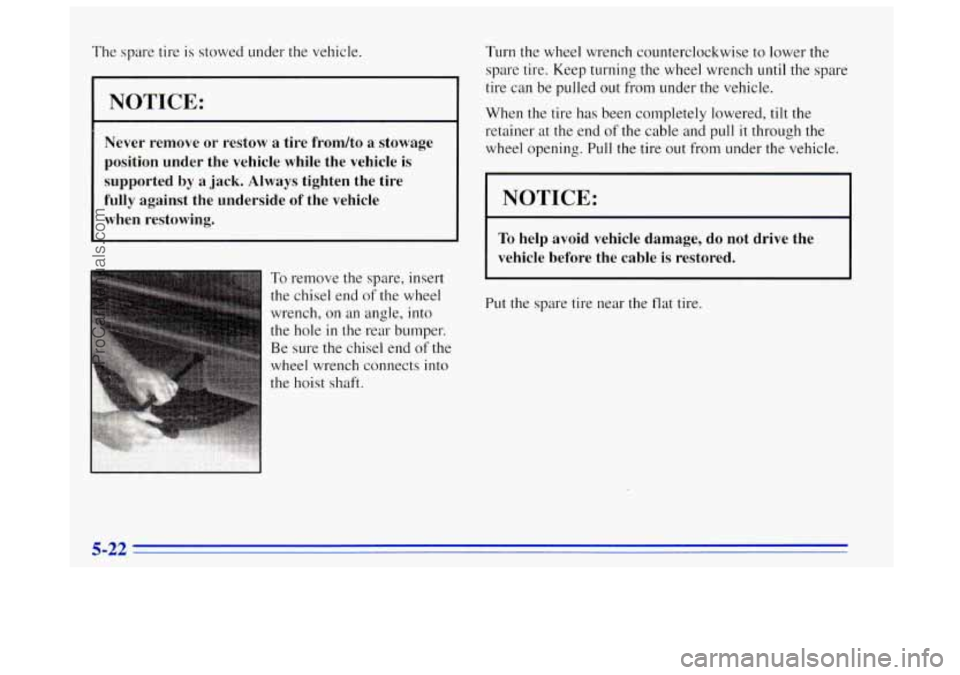
The spare tire is stowed under the vehicle.
I NOTICE:
Never remove or restow a tire frondto a stowage
position under the vehicle while the vehicle
is
supported by a jack. Always tighten the tire
fully against the underside of the vehicle when restawing.
To remove the spare, insert
the chisel end
of the wheel
wrench, on an angle, into
the hole in the rear bumper.
Be sure the chisel end of the
wheel wrench connects into
the hoist shaft. Turn the wheel wrench
counterclockwise to lower the
spare tire. Keep turning the wheel wrench
until the spare
tire can be pulled out
from under the vehicle.
When the tire has been completely lowered, tilt the
retainer at the end
of the cable and pull it through the
wheel opening. Pull the tire out from under the vehicle.
NOTICE:
To help avoid vehicle damage, do not drive the
vehicle before the cable
is restored.
Put the spare tire near the flat tire.
ProCarManuals.com
Page 203 of 340
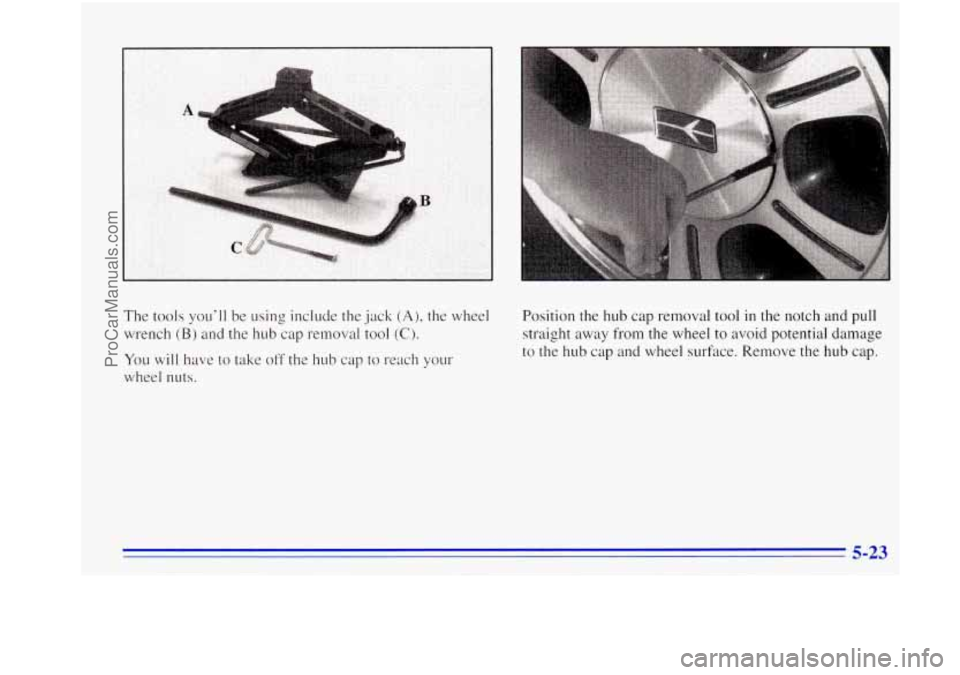
The tools you'll be using include the jack (A), the wheel
wrench
(B) and the hub cap removal tool (C).
You will have to take off the hub cap to reach your
wheel nuts. Position the
hub cap removal tool
in the notch and pull
straight away from the wheel to avoid potential damage
to the hub cap and wheel surface. Remove the hub cap.
ProCarManuals.com
Page 204 of 340
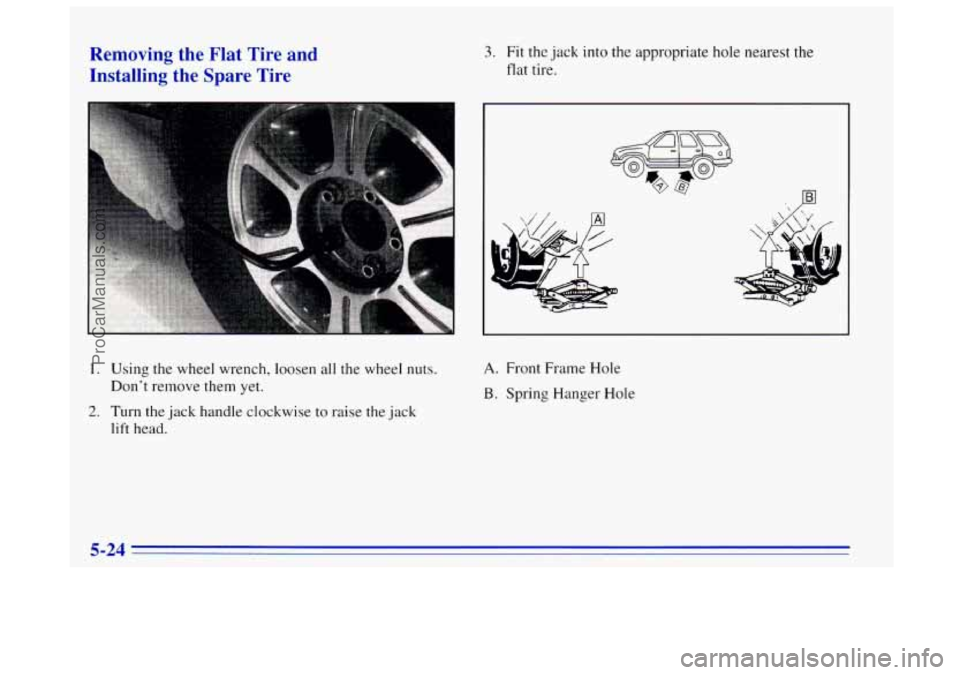
Removing the Flat Tire and
Installing the Spare Tire
I
1. Using the wheel wrench, loosen all the wheel nuts.
Don’t remove them yet.
lift head.
2. Turn the jack handle clockwise to raise the jack
3. Fit the jack into the appropriate hole nearest the
flat tire.
A. Front Frame Hole
B. Spring Hanger Hole
ProCarManuals.com
Page 205 of 340
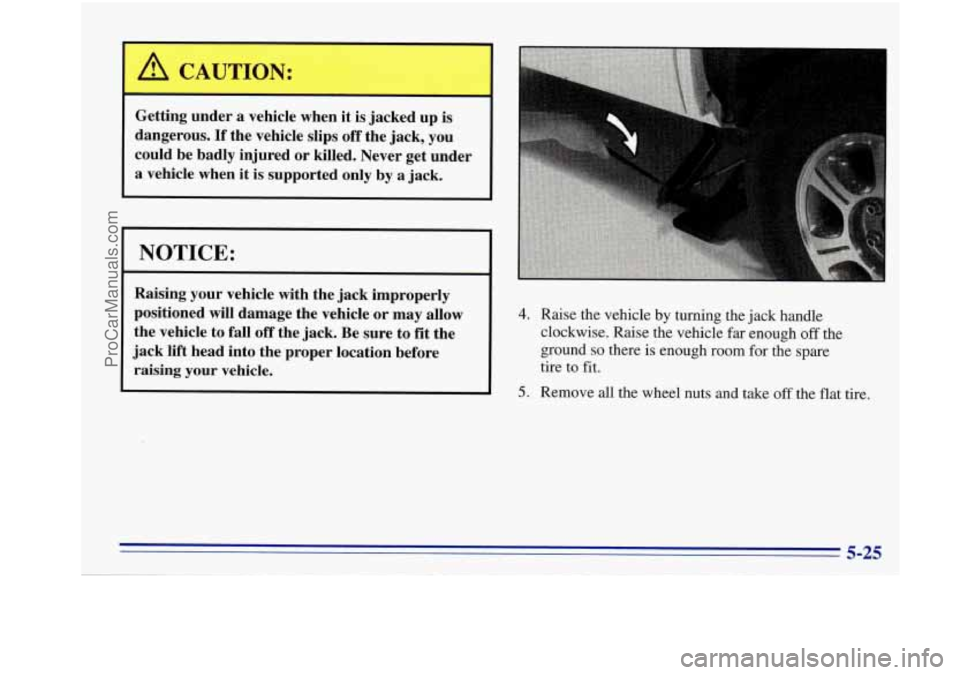
x CAUTION: 1 - - -
Getting under a vehicle when it is jacked up is
dangerous. If the vehicle slips off the jack, you
could be badly injured
or killed. Never get under
a vehicle when it is supported only by a jack.
NOTICE:
Raising your vehicle with the jack improperly
positioned will damage the, vehicle or may allow
the vehicle to fall off the jack. Be sure to
fit the
jack lift head into the proper location before
raising your vehicle.
4. Raise the vehicle by turning the jack handle
clockwise. Raise the vehicle far enough
off the
ground
so there is enough room for the spare
tire
to fit.
5. Remove all the wheel nuts and take off the flat tire.
5-25
ProCarManuals.com
Page 206 of 340
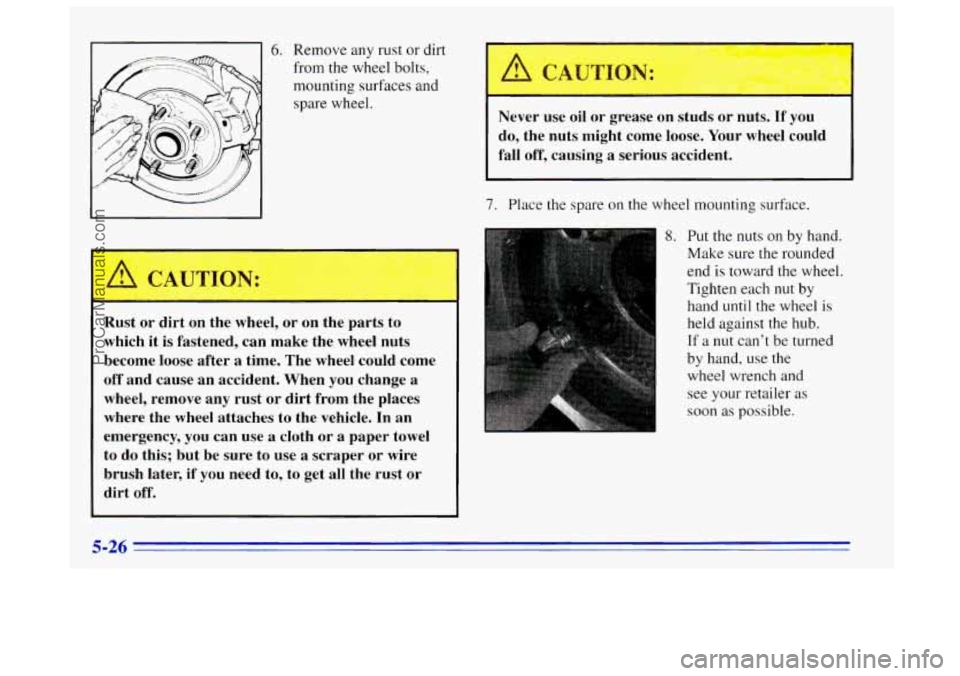
6. Remove any rust or dirt
from
the wheel bolts,
mounting surfaces and spare wheel.
Rust or dirt on the wheel, or on the parts to
which it is fastened, can make the wheel nuts
become loose after a time. The wheel could come
off and cause an accident. When
you change a
wheel, remove any rust or dirt from the places
where the wheel attaches to the vehicle.
In an
emergency, you can use
a cloth or a paper towel
to do this; but be sure to use a scraper or wire
brush later, if you need to, to get all the rust or
dirt off. Never use oil
or grease on studs
or nuts. If you
do, the nuts might come loose. Your wheel could
fall off, causing a serious accident.
7. Place the spare on the wheel mounting surface.
8. Put the nuts on by hand.
Make sure the rounded
end is toward the wheel.
Tighten
each nut by
hand
until the wheel is
held against the hub.
If a nut can't be turned
by hand, use the
wheel wrench and
see your retailer as
soon as possible,
ProCarManuals.com
Page 207 of 340
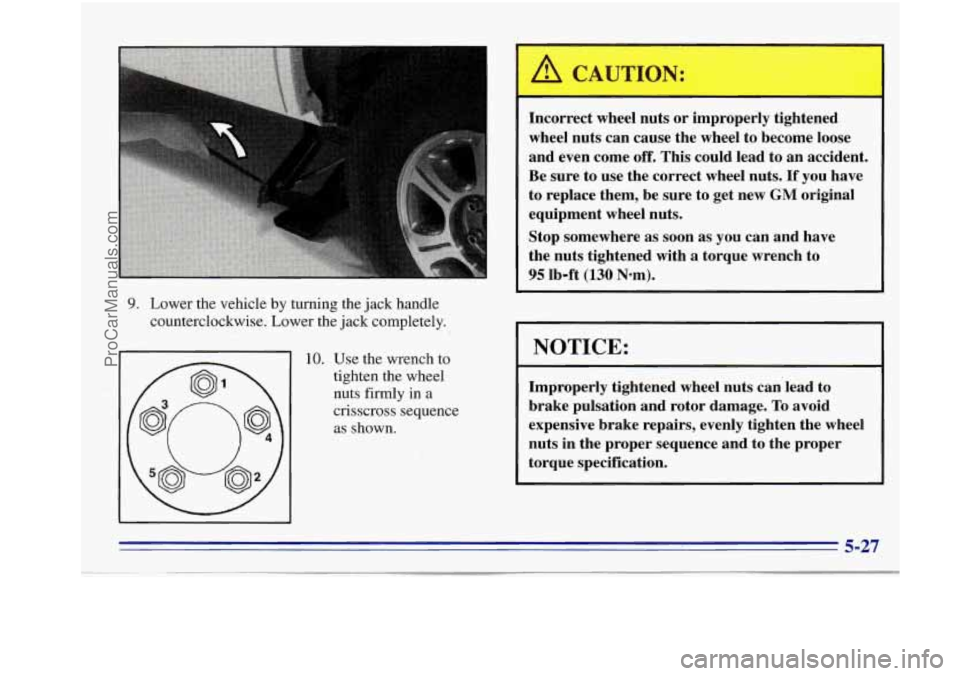
9. Lower the vehicle by turning the jack handle counterclockwise. Lower the jack completely.
10. Use the wrench to
tighten the wheel
nuts
firmly in a
crisscross sequence as shown.
A CAUTION:
Incorrect wheel nuts or improperly tightened
wheel nuts can cause the wheel to become loose
and even come
off. This could lead to an accident.
Be sure to use the correct wheel nuts.
If you have
to replace them, be sure to get new
GM original
equipment wheel nuts.
Stop somewhere as soon as you can and have
the nuts tightened with a torque wrench to
95 lb-ft
(130 Nom).
NOTICE:
Improperly tightened wheel nuts can'lead to
brake pulsation and rotor damage.
To avoid
expensive brake repairs, evenly tighten the wheel
nuts in the proper sequence and, to the proper
torque specification.
5-27
ProCarManuals.com
Page 208 of 340

Storing a Flat or Spare Tire and Tools Follow this diagram to store the spare or flat tire.
I A CAUTION:
Storing a jack, a tire or other equipment in the
passenger compartment
of the vehicle could
cause injury. In
a sudden stop or collision, loose
equipment could strike someone. Store all these
in the proper place.
B-I
A. Retainer
B. Valve Stem
(Pointed Down)
C. Spare Tire
D. Spring
E. Wheel Wrench
E Lower
G. Raise
H. Hoist Arm
1. Put the tire on the ground at the rear of the vehicle,
with the valve stem pointed down and to the rear.
2. Pull the retainer through the wheel.
3. Put the chisel end of the wheel wrench, on an angle,
through the hole
in the rear bumper and into the hoist
shaft. Turn the wheel wrench clockwise until
the tire
is raised against the underside
of the vehicle.
You will hear two “clicks” when the tire is secure,
but pull
on the tire to make sure.
ProCarManuals.com
Page 209 of 340

Return the jack, wheel wrench and wheel blocks to the
proper location
in your vehicle’s rear area. Secure the
items and replace the
jack cover.
L
A. Retainer E Wheel Blocks
B. Rubber Band G. Hub Cap
(Some Models) Removal
Tool
C.
Work Gloves H. Wheel Wrench
D. Mat I. Jack
E. Jack Storage Cover J. Jacking Instructions
If You’re Stuck: In Sand, Mud,
Ice or Snow
r vehicle is stuck is What you don’t want to do wne
to spin your wheels too fast. The method known as
“rocking” can help you get out when you’re stuck, but
you must use caution.
If you let your tires spin at high speed, they can
explode, and you or others could be injured.
And, the transmission or other parts
of the
vehicle can overheat. That could cause an engine
compartment fire or other damage. When you’re stuck, spin the wheels as little as possible. Don’t
spin the wheels above 35 mph
(55 kmh) as shown
on the speedometer.
ProCarManuals.com
Page 210 of 340
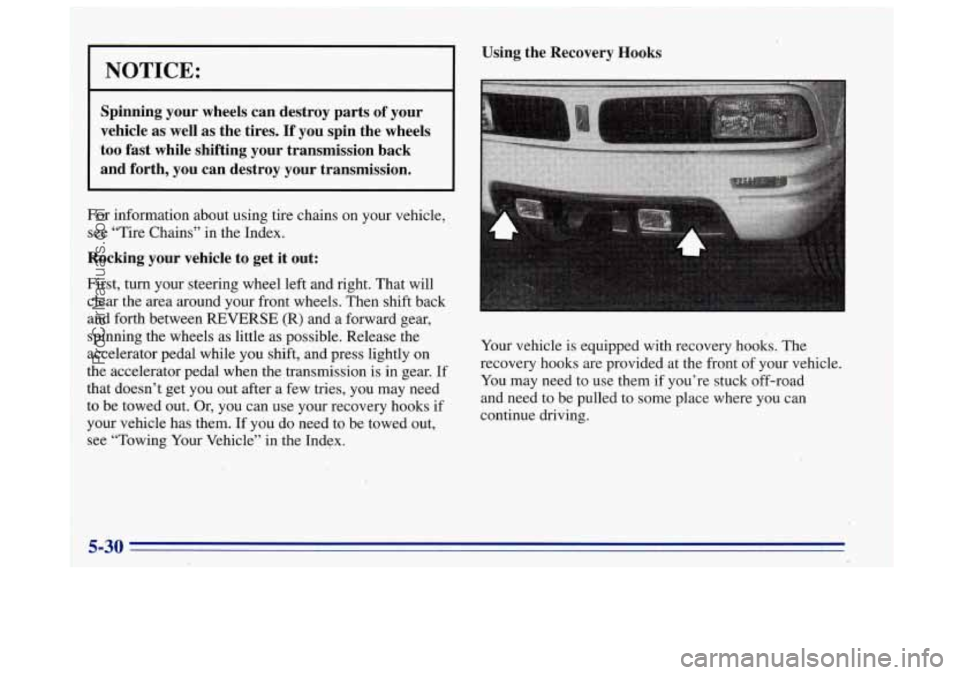
I NOTICE:
Spinning your wheels can destroy parts of your
vehicle as well as the tires.
If you spin the wheels
too fast while shifting your transmission back
and forth, you can destroy your transmission.
For information about using tire chains on your vehicle,
see “Tire Chains” in the Index.
Rocking your vehicle to get it out:
First, turn your steering wheel left and right. That will
clear the area around your front wheels. Then shift back
and forth between REVERSE (R) and a forward gear,
spinning the wheels as little as possible. Release the
accelerator pedal while you shift, and press lightly on
the accelerator pedal when the transmission is in gear. If
that doesn’t get you out after a few tries, you may need
to be towed out. Or, you can use your recovery hooks if
your vehicle has them.
If you do need to be towed out,
see “Towing Your Vehicle” in the Index.
Using the Recovery Hooks
Your vehicle is equipped with recovery hooks. The
recovery hooks are provided at the front
of your vehicle.
You may need to use them if you’re stuck off-road
and need
to be pulled to some place where you can
continue driving.
ProCarManuals.com